Mineralogical Evolution of High-pH/Low-pH Cement Pastes in Contact with Seawater
Abstract
:1. Introduction
2. Materials and Methods
2.1. Materials
2.2. Sample Preparation
2.3. Immersion Experiment
2.4. Solid-Phase Analyses
2.5. Aqueous-Phase Analyses
2.6. Thermodynamic Calculation
3. Results
3.1. Solid Characterization
3.2. Aqueous Chemistry
4. Discussion
4.1. Influence of Cement Types on Cement–Seawater Interactions
4.1.1. Mineral Transitions during Cement–Seawater Interactions
- The leaching of Na and K contained in Portland cement;
- The dissolution of portlandite (Ca(OH)2);
- The dissolution of calcium aluminate hydrates and decalcification of C-S-H;
- The dissolution of C-S-H.
4.1.2. Applicability of Thermodynamic Calculation for the Cement–Seawater Interaction
4.2. Influence of Aqueous Phase Chemistry on Cement Hydrate Alteration
5. Conclusions
Author Contributions
Funding
Data Availability Statement
Conflicts of Interest
References
- NUMO. The NUMO Pre-Siting SDM-Based Safety Case. NUMO-TR-21-01. 2021. Available online: https://www.numo.or.jp/technology/technical_report/pdf/NUMO-TR21-01_rev220222.pdf (accessed on 30 January 2024).
- Nakayama, S.; Sakamoto, Y.; Yamaguchi, T.; Akai, M.; Tanaka, T.; Sato, T.; Iida, Y. Dissolution of montmorillonite in compacted bentonite by highly alkaline aqueous solutions and diffusivity of hydroxide ions. Appl. Clay Sci. 2004, 27, 53–65. [Google Scholar] [CrossRef]
- Rozalén, M.L.; Huertas, F.J.; Brady, P.V.; Cama, J.; García-Palma, S.; Linares, J. Experimental study of the effect of pH on the kinetics of montmorillonite dissolution at 25 °C. Geochim. Cosmochim. Acta 2008, 72, 4224–4253. [Google Scholar] [CrossRef]
- Fernández, R.; Mäder, U.K.; Rodríguez, M.; Vigil de la Villa, R.; Cuevas, J. Alteration of compacted bentonite by diffusion of highly alkaline solutions. Eur. J. Mineral. 2009, 21, 725–735. [Google Scholar] [CrossRef]
- Moyce, E.B.A.; Roschelle, C.; Morris, K.; Milodowski, A.E.; Chen, X.; Thornton, S.; Small, J.S.; Shaw, S. Rock alteration in alkaline cement waters over 15 years and its relevance to the geological disposal of nuclear waste. Appl. Geochem. 2014, 50, 91–105. [Google Scholar] [CrossRef]
- Mäder, U.; Jenni, A.; Lerouge, C.; Gaboreau, S.; Miyoshi, S.; Kimura, Y.; Cloet, V.; Fukaya, M.; Claret, F.; Otake, T.; et al. 5-year chemico-physical evolution of concrete–claystone interfaces, Mont Terri rock laboratory (Switzerland). Swiss J. Geosci. 2017, 110, 307–327. [Google Scholar] [CrossRef]
- Taubald, H.; Bauer, A.; Schäfer, T.; Geckeis, H.; Satir, M.; Kim, J.I. Experimental investigation of the effect of high-pH solutions on the Opalinus Shale and the Hammerschmiede Smectite. Clay Miner. 2000, 35, 515–524. [Google Scholar] [CrossRef]
- González-Santamaría, D.E.; Fernández, R.; Ruiz, A.I.; Ortega, A.; Cuevas, J. High-pH/low pH ordinary Portland cement mortars impacts on compacted bentonite surfaces: Application to clay barriers performance. Appl. Clay Sci. 2020, 193, 105672. [Google Scholar] [CrossRef]
- Savage, D.; Walker, C.; Arthur, R.; Rochelle, C.; Oda, C.; Takase, H. Alteration of bentonite by hyperalkaline fluids: A review of the role of secondary minerals. Phys. Chem. Earth 2007, 32, 287–297. [Google Scholar] [CrossRef]
- García Calvo, J.L.; Hidalgo, A.; Alonso, C.; Fernández Luco, L. Development of low-pH cementitious materials for HLRW repositories: Resistance against ground waters aggression. Cem. Concr. Res. 2010, 40, 1290–1297. [Google Scholar] [CrossRef]
- Lothenbach, B.; Le Saout, G.; Ben Haha, M.; Figi, R.; Wieland, E. Hydration of a low-alkali CEM III/B–SiO2 cement (LAC). Cem. Concr. Res. 2012, 42, 410–423. [Google Scholar] [CrossRef]
- Lothenbach, B.; Rentsch, D.; Wieland, E. Hydration of a silica fume blended low-alkali shotcrete cement. Phys. Chem. Earth 2014, 70, 3–16. [Google Scholar] [CrossRef]
- Mihara, M.; Iriya, K.; Torii, K. Development of low–alkaline cement using pozzolans for geological disposal of long–lived radioactive waste. Doboku Gakkai Ronbunshuu F 2008, 64, 92–103. [Google Scholar] [CrossRef]
- METI. Nationwide Map of “Scientific Features” Relevant for Geological Disposal. Available online: https://www.enecho.meti.go.jp/en/category/electricity_and_gas/nuclear/rwm/pdf/map_en.pdf (accessed on 30 January 2024).
- De Weerdt, K.; Justnes, H. The effect of sea water on the phase assemblage of hydrated cement paste. Cem. Concr. Compos. 2015, 55, 215–222. [Google Scholar] [CrossRef]
- Jakobsen, U.H.; De Weerdt, K.; Geiker, M.R. Elemental zonation in marine concrete. Cem. Concr. Res. 2016, 85, 12–27. [Google Scholar] [CrossRef]
- Yi, Y.; Zhu, D.; Guo, S.; Zhang, Z.; Shi, C. A review on the deterioration and approaches to enhance the durability of concrete in the marine environment. Cem. Concr. Compos. 2020, 113, 103695. [Google Scholar] [CrossRef]
- Ting, M.Z.Y.; Yi, Y. Durability of cementitious materials in seawater environment: A review on chemical interactions, hardened-state properties and environmental factors. Constr. Build. Mater. 2023, 367, 130224. [Google Scholar] [CrossRef]
- Qu, F.; Li, W.; Dong, W.; Tam, V.W.Y.; Yu, T. Durability deterioration of concrete under marine environment from material to structure: A critical review. J. Build. Eng. 2021, 35, 102074. [Google Scholar] [CrossRef]
- De Weerdt, K.; Bernard, E.; Kunther, W.; Pedersen, M.T.; Lothenbach, B. Phase changes in cementitious materials exposed to saline solutions. Cem. Concr. Res. 2023, 165, 107071. [Google Scholar] [CrossRef]
- Fernández-Jiménez, A.; Palomo, A. Characterisation of fly ashes. Potential reactivity as alkaline cements. Fuel 2003, 82, 2259–2265. [Google Scholar] [CrossRef]
- Oey, T.; Timmons, J.; Stutzman, P.; Bullard, J.W.; Balonis, M.; Bauchy, M.; Sant, G. An improved basis for characterizing the suitability of fly ash as a cement replacement agent. J. Am. Ceram. Soc. 2017, 100, 4785–4800. [Google Scholar] [CrossRef]
- Kuenzel, C.; Ranjbar, N. Dissolution mechanism of fly ash to quantify the reactive aluminosilicates in geopolymerisation. Res. Conse. Recycl. 2019, 150, 104421. [Google Scholar] [CrossRef]
- JIS R 5204; Chemical Analysis Method of Cement by X-ray Fluorescence. Japanese Standards Association (JSA): Tokyo, Japan, 2019.
- JIS A 6201; Fly Ash for Use in Concrete. Japanese Standards Association (JSA): Tokyo, Japan, 2015.
- JIS A 6207; Silica Fume for Use in Concrete. Japanese Standards Association (JSA): Tokyo, Japan, 2016.
- Lothenbach, B.; Kulik, D.A.; Matschei, T.; Balonis, M.; Baquerizo, L.; Dilnesa, B.; Miron, G.D.; Myers, R.J. Cemdata18: A chemical thermodynamic database for hydrated Portland cements and alkali-activated materials. Cem. Concr. Res. 2019, 115, 472–506. [Google Scholar] [CrossRef]
- Nied, D.; Enemark-Rasmussen, K.; L’Hopital, E.; Skibsted, E.; Lothenbach, B. Properties of magnesium silicate hydrates (M-S-H). Cem. Concr. Res. 2016, 79, 323–332. [Google Scholar] [CrossRef]
- Rozov, K.B.; Berner, U.; Kulik, D.A.; Diamond, L.W. Solubility and Thermodynamic Properties of Carbonate-Bearing Hydrotalcite—Pyroaurite Solid Solutions with A 3:1 Mg/(Al+Fe) Mole Ratio. Clays Clay Miner. 2011, 59, 215–232. [Google Scholar] [CrossRef]
- Zuo, Y. Thermodynamic modeling of the phase evolution in alkali-activated slag cements with sulfate salt exposure. J. Am. Ceram. Soc. 2022, 105, 7658–7675. [Google Scholar] [CrossRef]
- Dilnesa, B.Z.; Lothenbach, B.; Renaudin, G.; Wichser, A.; Kulik, D. Synthesis and characterization of hydrogarnet Ca3(AlxFe1−x)2(SiO4)y(OH)4(3−y). Cem. Concr. Res. 2014, 59, 96–111. [Google Scholar] [CrossRef]
- Cavani, F.; Trifirò, F.; Vaccari, A. Hydrotalcite-type anionic clays: Preparation, properties and applications. Catal. Today 1991, 11, 173–301. [Google Scholar] [CrossRef]
- Morimoto, K.; Anraku, S.; Hoshino, J.; Yoneda, T.; Sato, T. Surface complexation reactions of inorganic anions on hydrotalcite-like compounds. J. Colloid Interface Sci. 2012, 384, 99–104. [Google Scholar] [CrossRef]
- Berner, R.A. The role of magnesium in the crystal growth of calcite and aragonite from sea water. Geochim. Cosmochim. Acta 1975, 39, 489–504. [Google Scholar] [CrossRef]
- Buenfeld, N.R.; Newman, J.B. The development and stability of surface layers on concrete exposed to sea-water. Cem. Concr. Res. 1986, 16, 721–732. [Google Scholar] [CrossRef]
- Chavagnac, V.; Ceuleneer, G.; Monnin, C.; Lansac, B.; Hoareau, G.; Boulart, C. Mineralogical assemblages forming at hyperalkaline warm springs hosted on ultramafic rocks: A case study of Oman and Ligurian ophiolites. Geochem. Geophys. Geosyst. 2013, 14, 2474–2495. [Google Scholar] [CrossRef]
- Díaz-Hernández, J.L.; Sánchez-Navas, A.; Reyes, E. Isotopic evidence for dolomite formation in soils. Chem. Geol. 2013, 347, 20–33. [Google Scholar] [CrossRef]
- Nyirő-Kósa, I.; Rostási, Á.; Bereczk-Tompa, É.; Cora, I.; Koblar, M.; Kovács, A.; Pósfai, M. Nucleation and growth of Mg-bearing calcite in a shallow, calcareous lake. Earth Planet. Sci. Lett. 2018, 496, 20–28. [Google Scholar] [CrossRef]
- Molnár, Z.; Pekker, P.; Dódony, I.; Pósfai, M. Clay minerals affect calcium (magnesium) carbonate precipitation and aging. Earth Planet. Sci. Lett. 2021, 567, 116971. [Google Scholar] [CrossRef]
- Tosca, N.J.; Masterson, A.L. Chemical controls on incipient Mg-silicate crystallization at 25 °C: Implications for early and late diagenesis. Clay Miner. 2014, 49, 165–194. [Google Scholar] [CrossRef]
- Roosz, C.; Grangeon, S.; Blanc, P.; Montouillout, V.; Lothenbach, B.; Henocq, P.; Giffaut, E.; Vieillard, P.; Gaboreau, S. Crystal structure of magnesium silicate hydrates (M-S-H): The relation with 2:1 Mg–Si phyllosilicates. Cem. Concr. Res. 2015, 73, 228–237. [Google Scholar] [CrossRef]
- Engelhardt, G.; Michel, D. High-Resoluion Solid-State NMR of Silicates and Zeolites; John Wiley & Sons: New York, NY, USA, 1987. [Google Scholar]
- Bernard, E.; Lothenbach, B.; Le Goff, F.; Pochard, I.; Dauzères, A. Effect of magnesium on calcium silicate hydrate (C-S-H). Cem. Concr. Res. 2017, 97, 61–72. [Google Scholar] [CrossRef]
- Bernard, E.; Lothenbach, B.; Cau-Dit-Coumes, C.; Pochard, I.; Rentsch, D. Aluminum incorporation into magnesium silicate hydrate (M-S-H). Cem. Concr. Res. 2020, 128, 105931. [Google Scholar] [CrossRef]
- Vespa, M.; Lothenbach, B.; Dähn, R.; Huthwelker, T.; Wieland, E. Characterisation of magnesium silicate hydrate phases (M-S-H): A combined approach using synchrotron-based absorption-spectroscopy and ab initio calculations. Cem. Concr. Res. 2018, 109, 175–183. [Google Scholar] [CrossRef]
- Nishiki, Y.; Cama, J.; Otake, T.; Kikuchi, R.; Shimbashi, M.; Sato, T. Formation of magnesium silicate hydrate (M-S-H) at pH 10 and 50 °C in open-flow systems. Appl. Geochem. 2023, 148, 105544. [Google Scholar] [CrossRef]
- Inoue, K.; Nishiki, Y.; Fukushi, K.; Suma, R.; Sato, T.; Sakuma, H.; Tamura, K.; Yokoyama, S.; Shimbashi, M.; Mizukami, T.; et al. Systematic comparison of Mg K-edge XANES spectra of magnesium-bearing clay minerals and magnesium silicate hydrates: A promising tool for identifying magnesium silicate hydrate in natural samples. Appl. Clay Sci. 2023, 245, 107152. [Google Scholar] [CrossRef]
- Berner, U.R. Evolution of pore water chemistry during degradation of cement in a radioactive waste repository environment. Waste Manag. 1992, 12, 201–219. [Google Scholar] [CrossRef]
- Ganjian, E.; Pouya, H.S. Effect of magnesium and sulfate ions on durability of silica fume blended mixes exposed to the seawater tidal zone. Cem. Concr. Res. 2005, 35, 1332–1343. [Google Scholar] [CrossRef]
- Ganjian, E.; Pouya, H.S. The effect of Persian Gulf tidal zone exposure on durability of mixes containing silica fume and blast furnace slag. Constr. Build. Mater. 2009, 23, 644–652. [Google Scholar] [CrossRef]
- Lothenbach, B.; Scrivener, K.; Hooton, R.D. Supplementary cementitious materials. Cem. Concr. Res. 2011, 41, 1244–1256. [Google Scholar] [CrossRef]
- Thomas, M.D.A.; Hooton, R.D.; Scott, A.; Zibara, H. The effect of supplementary cementitious materials on chloride binding in hardened cement paste. Cem. Concr. Res. 2012, 42, 1–7. [Google Scholar] [CrossRef]
- Roosz, C.; Vieillard, P.; Blanc, P.; Gaboreau, S.; Gailhanou, H.; Braithwaite, D.; Montouillout, V.; Denoyel, R.; Henocq, P.; Madé, B. Thermodynamic properties of C-S-H, C-A-S-H and M-S-H phases: Results from direct measurements and predictive modelling. Appl. Geochem. 2018, 92, 140–156. [Google Scholar] [CrossRef]
- Shimbashi, M.; Sato, T.; Yamakawa, M.; Fujii, N.; Otake, T. Formation of Fe- and Mg-Rich Smectite under Hyperalkaline Conditions at Narra in Palawan, the Philippines. Minerals 2018, 8, 155. [Google Scholar] [CrossRef]
- Nishiki, Y.; Sato, T.; Katoh, T.; Otake, T.; Kikuchi, R. Percipitation of magnesium silicatehydrates in natural alkaline surface environments. Clay Sci. 2020, 24, 1–13. [Google Scholar] [CrossRef]
- Shimbashi, M.; Yokoyama, S.; Kikuchi, R.; Otake, T.; Sato, T. Characteristics and Formation Pathways of Iron- and Magnesium-Silicate-Hydrates and Smectites Under Natural Alkaline Conditions. Clays Clay Miner. 2022, 70, 492–513. [Google Scholar] [CrossRef]
- Kulik, D.A.; Miron, G.D.; Lothenbach, B. A structurally-consistent CASH+ sublattice solid solution model for fully hydrated C-S-H phases: Thermodynamic basis, methods, and Ca-Si-H2O core sub-model. Cem. Concr. Res. 2022, 151, 106585. [Google Scholar] [CrossRef]
- Myers, R.J.; Bernal, S.A.; Provis, J.L. A thermodynamic model for C-(N-)A-S-H gel: CNASH_ss. Derivation and validation. Cem. Concr. Res. 2014, 66, 27–47. [Google Scholar] [CrossRef]
- Haas, J.; Nonat, A. From C–S–H to C–A–S–H: Experimental study and thermodynamic modelling. Cem. Concr. Res. 2015, 68, 124–138. [Google Scholar] [CrossRef]
- Myers, R.J.; Lothenbach, B.; Bernal, S.A.; Provis, J.L. Thermodynamic modelling of alkali-activated slag cements. Appl. Geochem. 2015, 61, 233–247. [Google Scholar] [CrossRef]
- Bernard, E.; Zucha, W.J.; Lothenbach, B.; Mäder, U. Stability of hydrotalcite (Mg-Al layered double hydroxide) in presence of different anions. Cem. Concr. Res. 2022, 152, 106674. [Google Scholar] [CrossRef]
- Miyata, S. Anion-Exchange Properties of Hydrotalcite-Like Compounds. Clays Clay Miner. 1983, 31, 305–311. [Google Scholar] [CrossRef]
- Dauzeres, A.; Achiedo, G.; Nied, D.; Bernard, E.; Alahrache, S.; Lothenbach, B. Magnesium perturbation in low-pH concretes placed in clayey environment—Solid characterizations and modeling. Cem. Concr. Res. 2016, 79, 137–150. [Google Scholar] [CrossRef]
- Santhanam, M.; Cohen, M.; Olek, J. Differentiating seawater and groundwater sulfate attack in Portland cement mortars. Cem. Concr. Res. 2006, 36, 2132–2137. [Google Scholar] [CrossRef]
- El-Khoury, M.; Roziere, E.; Grondin, F.; Cortas, R.; Chehade, F.H. Experimental evaluation of the effect of cement type and seawater salinity on concrete offshore structures. Constr. Build. Mater. 2022, 322, 126471. [Google Scholar] [CrossRef]
- Schwotzer, M.; Konno, K.; Kaltenbach, J.; Gerdes, A. The rim zone of cement-based materials—Barrier or fast lane for chemical degradation? Cem. Concr. Compos. 2016, 74, 236–243. [Google Scholar] [CrossRef]
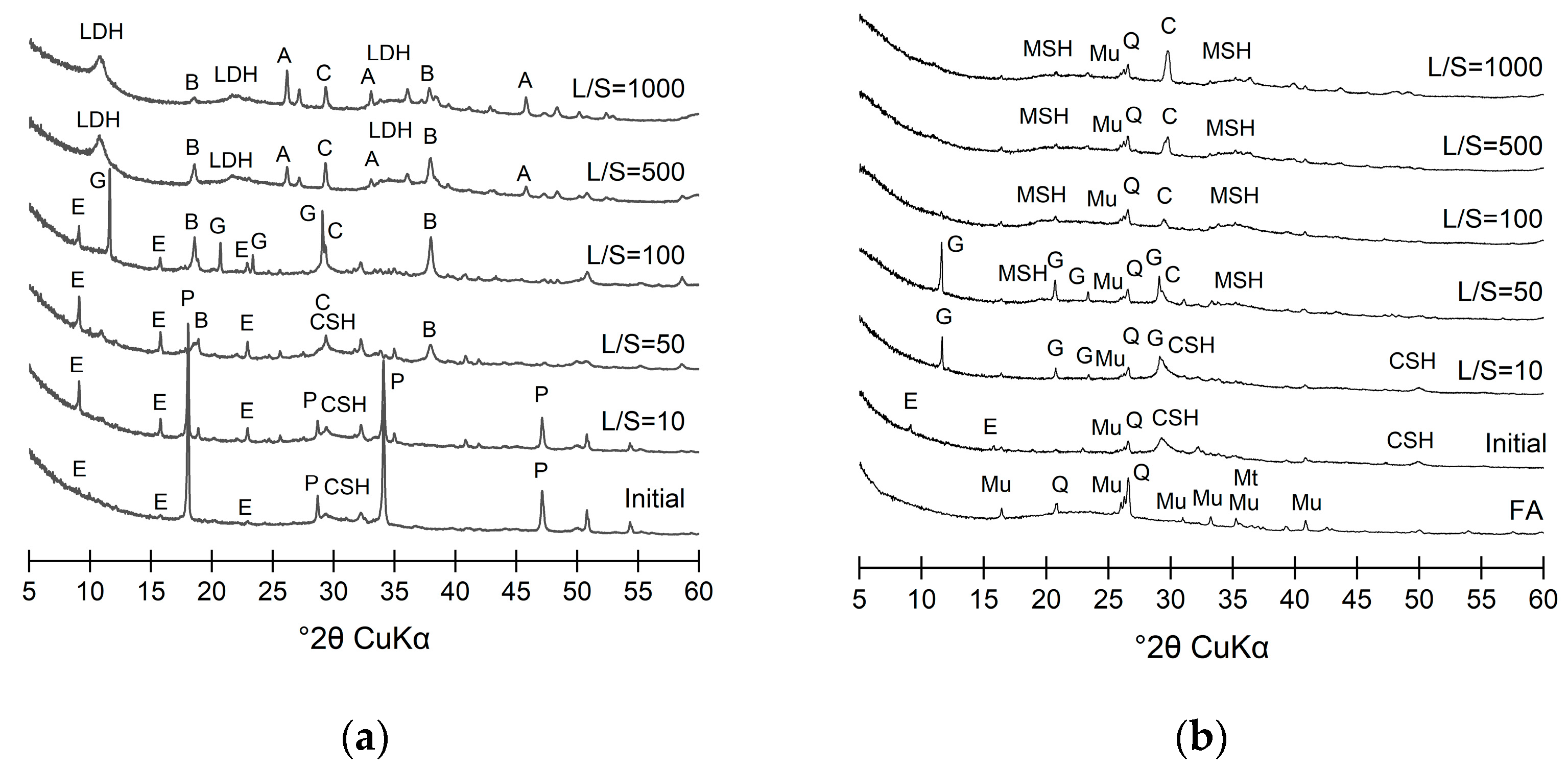
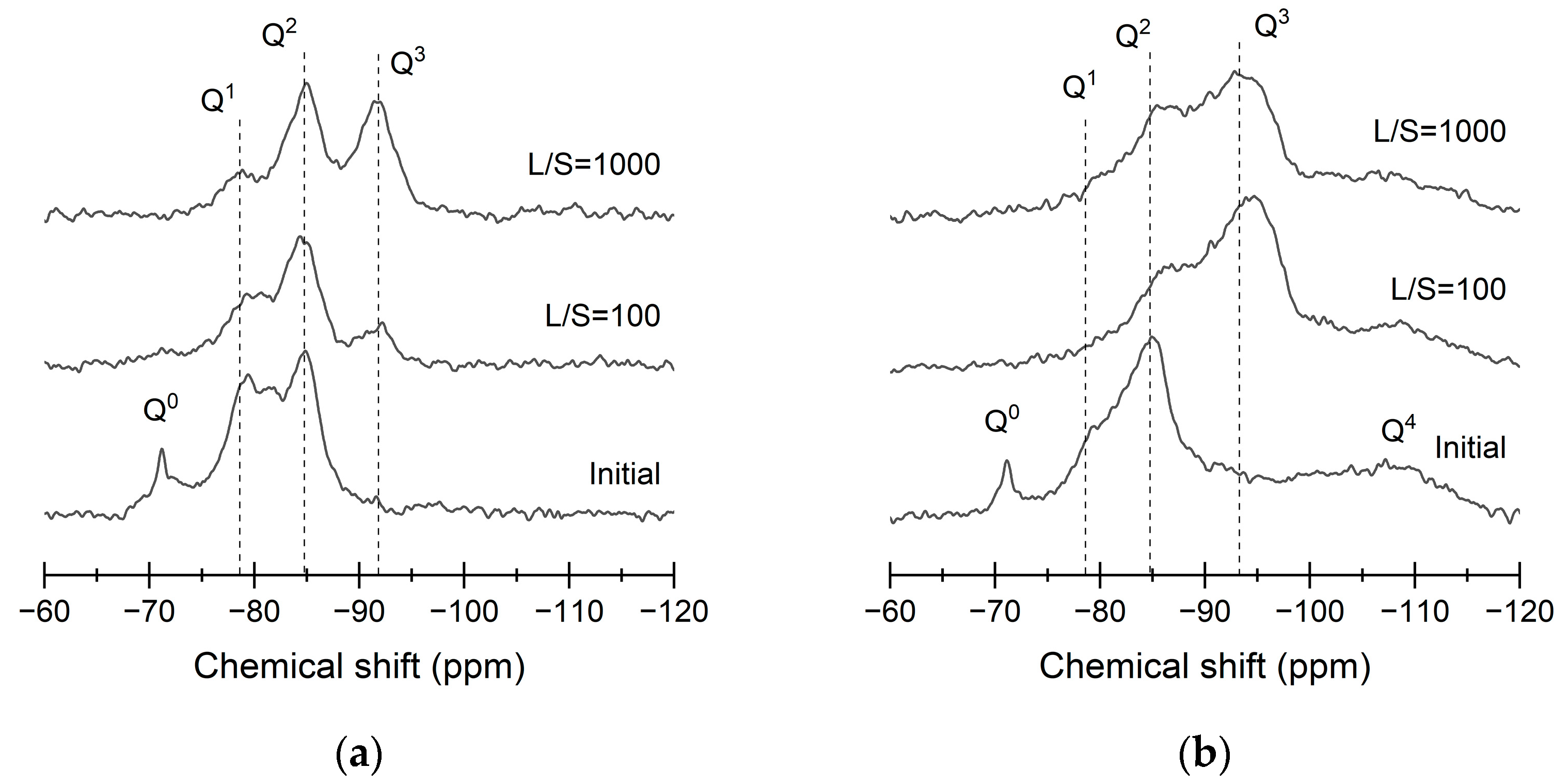
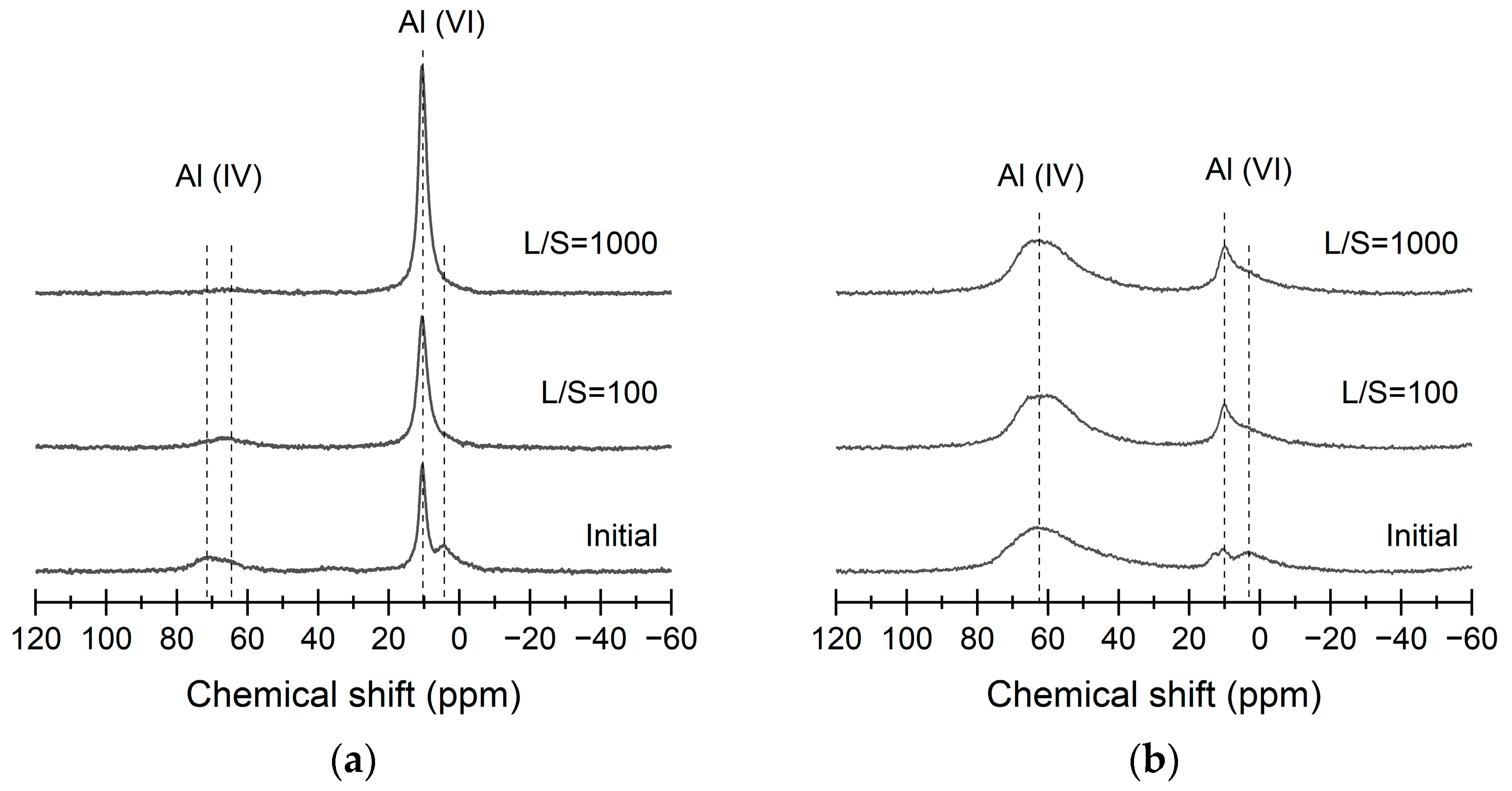
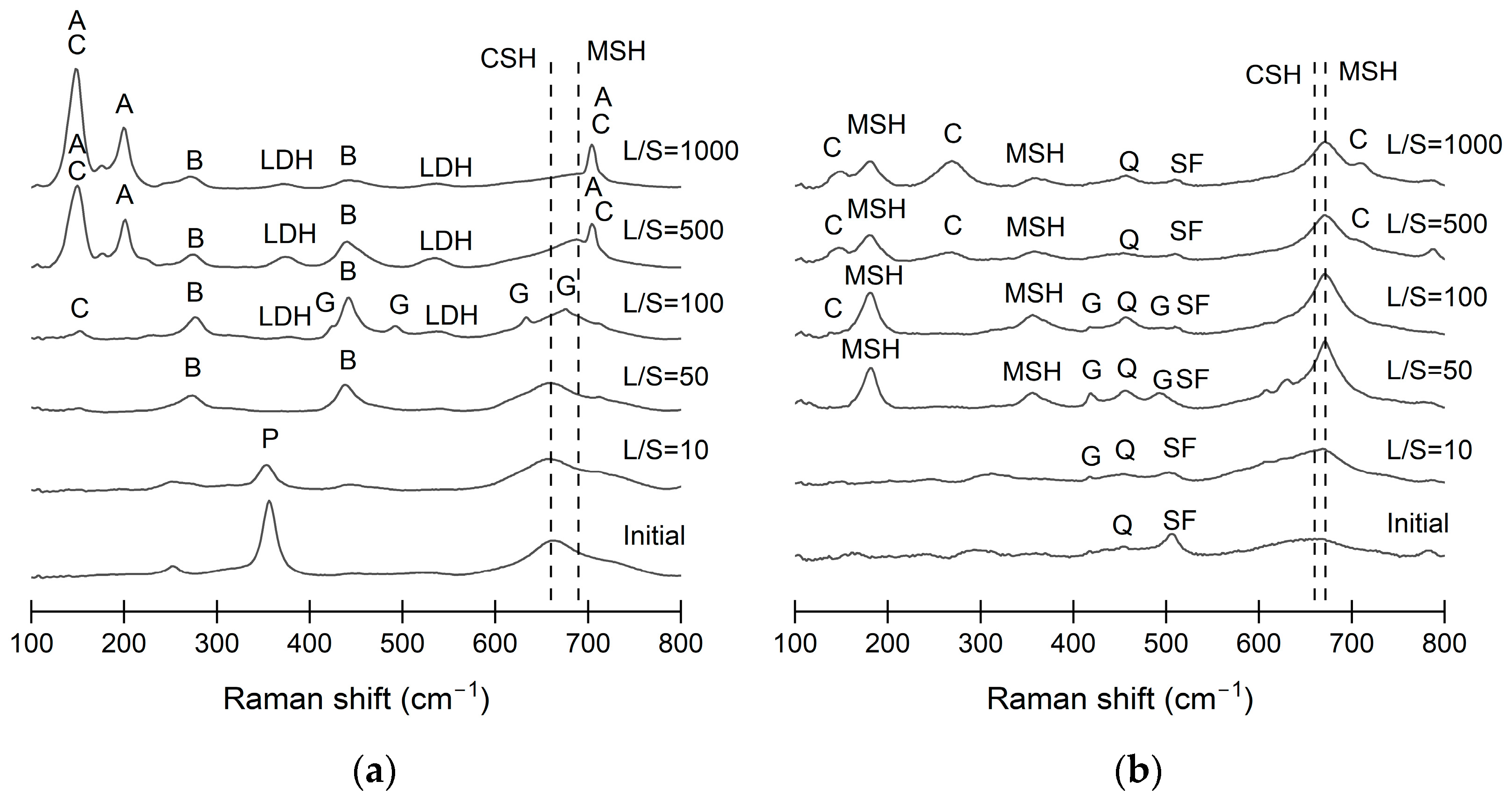

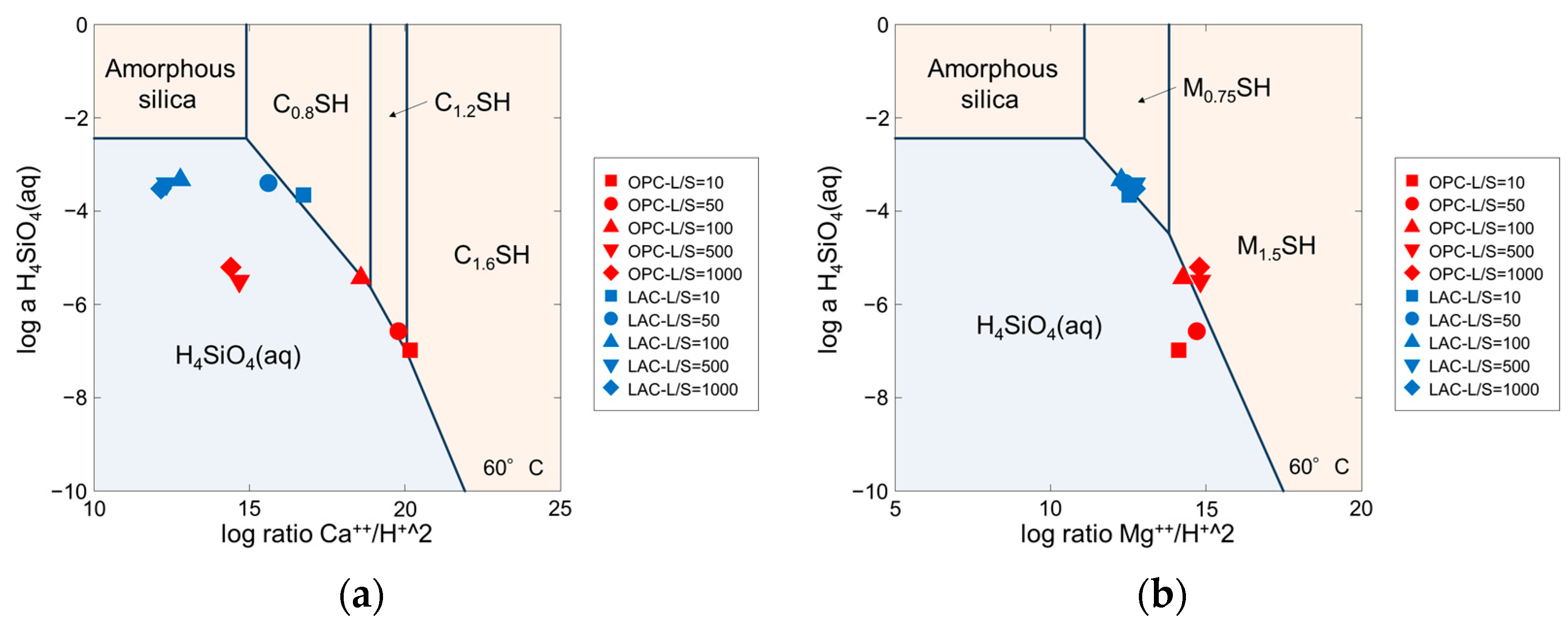
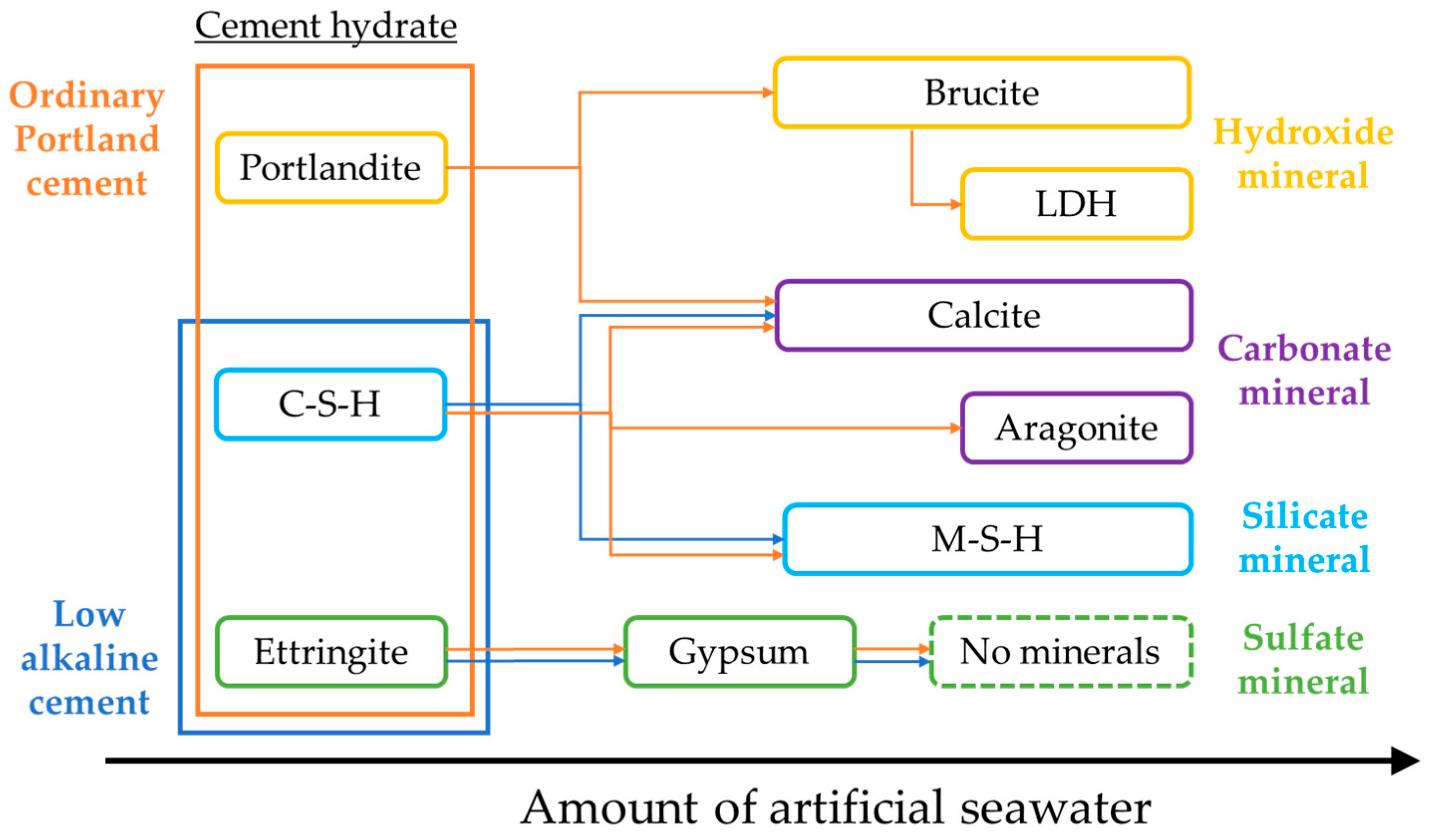

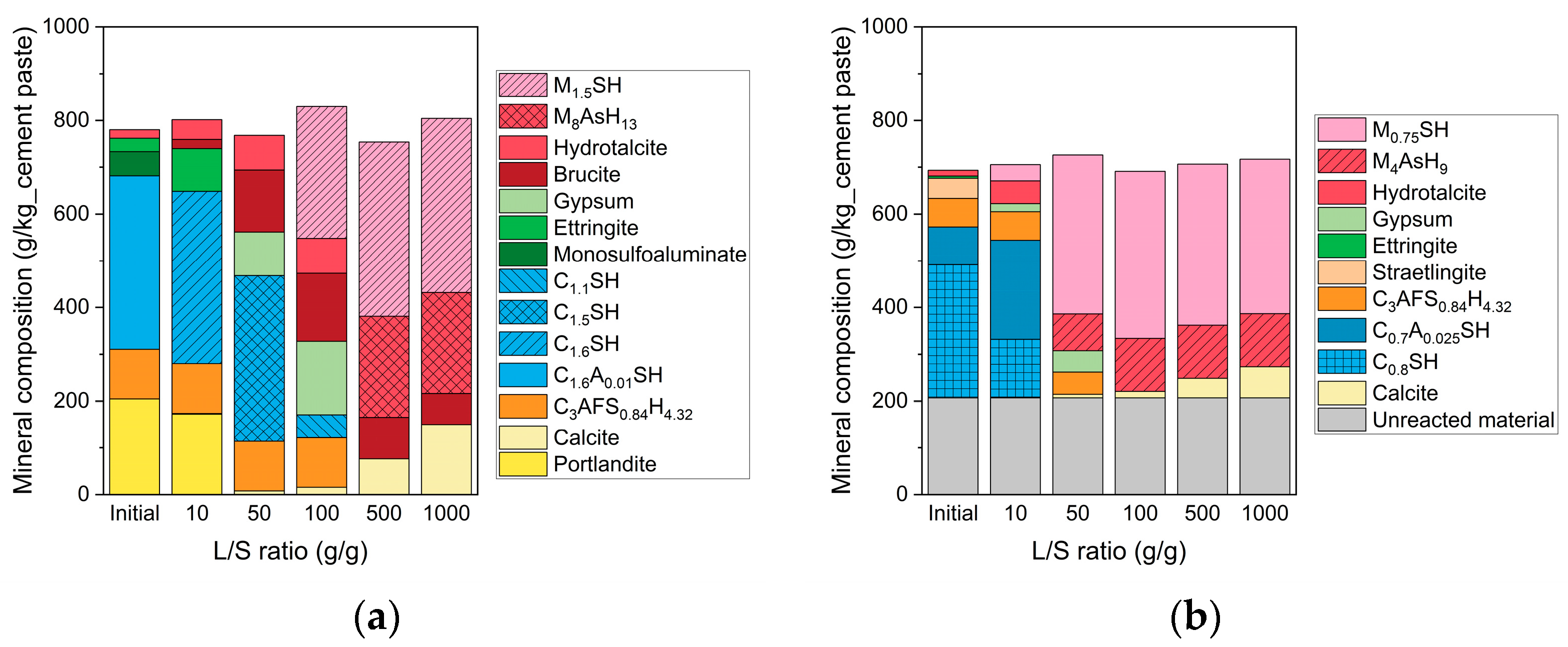
| Component | Composition (wt.%) | ||||||||
|---|---|---|---|---|---|---|---|---|---|
| CaO | SiO2 | Al2O3 | Fe2O3 | MgO | Na2O | K2O | SO3 | L.O.I 1 | |
| Ordinary Portland cement (OPC) | 64.97 | 21.66 | 4.76 | 3.18 | 1.08 | 0.34 | 0.43 | 2.04 | 0.97 |
| Silica fume (SF) | 0.33 | 95.84 | 0.52 | 0.17 | 0.43 | 0.14 | 0.70 | 0.09 | 0.80 |
| Fly ash (FA) | 4.70 | 55.06 | 24.30 | 6.42 | 1.99 | 1.43 | 1.25 | 0.83 | 1.70 |
| Mineral | Composition (Weight %) |
|---|---|
| Quartz (SiO2) | 5.52 |
| Mullite (3Al2O3·2SiO2) | 10.77 |
| Magnetite (Fe3O4) | 1.12 |
| Glass (4.8SiO2·Al2O3) 1 | 82.59 |
| Component | Concentration (mol/L) |
|---|---|
| Na+ | 4.5 × 10−1 |
| Mg2+ | 5.5 × 10−2 |
| Ca2+ | 1.0 × 10−2 |
| K+ | 1.0 × 10−2 |
| Sr2+ | 1.6 × 10−4 |
| Cl− | 5.6 × 10−1 |
| SO42− | 2.9 × 10−2 |
| HCO3− | 2.4 × 10−3 |
| Br− | 8.4 × 10−4 |
| BO33− | 4.4 × 10−4 |
| F− | 7.1 × 10−5 |
| Phase | Reaction | Log10 Kso at 60 °C | Sources |
|---|---|---|---|
| M-S-H | |||
| M0.75SH | Mg1.5Si2O5.5(H2O)2.5 + 3H+ = 1.5Mg2+ + 2H4SiO4 | 11.76 | [28] |
| M1.5SH | Mg1.5SiO3.5(H2O)2.5 + 3H+ = 1.5Mg2+ + H4SiO4 + 2H2O | 16.23 | [28] |
| Mg-Al/Fe-CO3 LDH | |||
| Mg2Alc0.5OH | Mg2Al(OH)6(CO3)0.5(H2O)2 + 6.5H+ = 2Mg2+ + Al3+ + 0.5HCO3− + 8H2O | 28.72 | [29] |
| Mg2Fec0.5OH | Mg2Fe(OH)6(CO3)0.5(H2O)2 + 6.5H+ = 2Mg2+ + Fe3+ + 0.5HCO3− + 8H2O | 27.70 | [29] |
| Mg3Alc0.5OH | Mg3Al(OH)8(CO3)0.5(H2O)2.5 + 8.5H+ = 3Mg2+ + Al3+ + 0.5HCO3− + 10.5H2O | 43.43 | [29] |
| Mg3Fec0.5OH | Mg3Fe(OH)8(CO3)0.5(H2O)2.5 + 8.5H+ = 3Mg2+ + Fe3+ + 0.5HCO3− + 10.5H2O | 42.19 | [29] |
| Mg-Al-SO4 LDH | |||
| M4AsH9 | Mg4Al2(OH)12SO4(H2O)3 + 12H+ = 4Mg2+ + 2Al3+ + SO42− + 15H2O | 42.91 | [30] |
| M6AsH11 | Mg6Al2(OH)16SO4(H2O)3 + 16H+ = 6Mg2+ + 2Al3+ + SO42− + 19H2O | 72.25 | [30] |
| M8AsH13 | Mg8Al2(OH)20SO4(H2O)3 + 20H+ = 8Mg2+ + 2Al3+ + SO42− + 23H2O | 101.69 | [30] |
| Siliceous hydrogarnet | |||
| C3AFS0.84H4.32 | (AlFeO3)(Ca3O3(SiO2)0.84(H2O)4.32) + 12H+ = 3Ca2+ + Al3+ + Fe3+ + 0.84 H4SiO4 + 8.64H2O | 56.49 | [31] |
Disclaimer/Publisher’s Note: The statements, opinions and data contained in all publications are solely those of the individual author(s) and contributor(s) and not of MDPI and/or the editor(s). MDPI and/or the editor(s) disclaim responsibility for any injury to people or property resulting from any ideas, methods, instructions or products referred to in the content. |
© 2024 by the authors. Licensee MDPI, Basel, Switzerland. This article is an open access article distributed under the terms and conditions of the Creative Commons Attribution (CC BY) license (https://creativecommons.org/licenses/by/4.0/).
Share and Cite
Kobayashi, Y.; Sato, T. Mineralogical Evolution of High-pH/Low-pH Cement Pastes in Contact with Seawater. Minerals 2024, 14, 285. https://doi.org/10.3390/min14030285
Kobayashi Y, Sato T. Mineralogical Evolution of High-pH/Low-pH Cement Pastes in Contact with Seawater. Minerals. 2024; 14(3):285. https://doi.org/10.3390/min14030285
Chicago/Turabian StyleKobayashi, Yutaro, and Tsutomu Sato. 2024. "Mineralogical Evolution of High-pH/Low-pH Cement Pastes in Contact with Seawater" Minerals 14, no. 3: 285. https://doi.org/10.3390/min14030285





